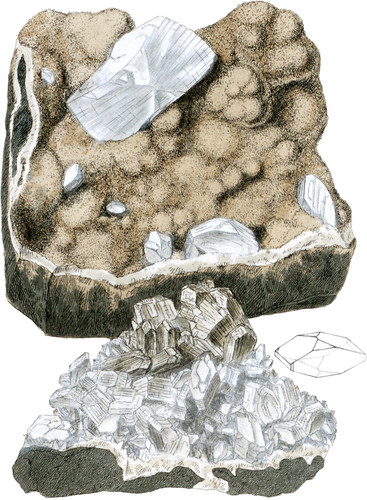 Enlarge
Enlarge
Exotic Mineralogy
Foliated Stilbite
- Syn.
- Ichthyophthalmite. Brit. Min. tab. 520, lower fig.
- Stilbite anamorphique. Haüy III. 163, tab. 49.
- Stilbite, in hexahedral prisms. Aikin, 209.
- Foliated Zeolite. Jameson, ed. 2, I, 307.
- Blätter Zeolith. Werner.
After the plan adopted in the Systematical Index to British Mineralogy, of treating very distinct varieties, or doubtful species, as sections of the principal species they are allied to, it is found convenient to distinguish the mineral before us as a section of Stilbite, of which Haüy, and after him many other mineralogists, guided by the measures of the crystals, although not quite satisfactorily ascertained, have considered it only a variety. Its superior lustre and hardness, together with the different symmetry of its crystals, lead to the suspicion of its being a distinct species, especially when we consider that it commonly accompanies the duller, columnar crystals of Stilbite, and that the same characters remain readily distinguishable even when the colour of both is a strong brick red, as in the figures in British Mineralogy, table 260 and 520. In the description that accompanies the latter figure, we were led by the lustre to believe that, both it and the mineral now under consideration, were varieties of Iehthyophthalmite, but this opinion is not supported by analylis, and some other considerations incline us to withdraw it, particularly the direction of the striæ upon the sides not being perpendicular to the pearly faces, as they are in that substance, (see Bournon’s Catalogue, p. 105.) The analysis of the Foliated Stilbite is as follows:—
| Meyer. | Vauquelin. | |
|---|---|---|
| Silica | 58.3 | 52.6 |
| Argilla | 17.5 | 17.5 |
| Lime | 6.6 | 9.0 |
| Water | 17.5 | 18.5 |
| 99.9 | 97.6 |
by which it appears that the Argilla and Lime are in very different proportions to those contained in the Ichthyophthalmite, which holds above 24 percent, of Lime, and scarcely any Argilla.
The upper specimen is a mass of Calcedony, darkly Coloured by Chlorite, with a mixture of Quartz and Zeolite encrusting it; upon it are deposited several distinct crystals of the foliated Stilhite. The other specimen is part of the side of a cavity in Wacke, lined with snow-white crystals of the same Zeolite, mixed with a few crystals of prismatic Stilhite, distinguished, as is commonly the case, by a yellow tinge and less brilliancy: it is from Ferroë.

